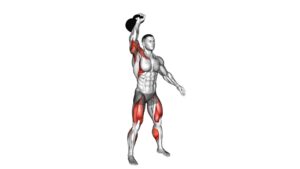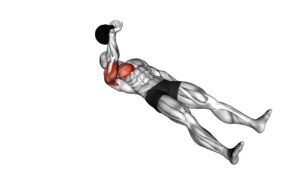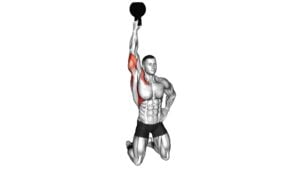Kettlebell Arm Bar (male) – Video Exercise Guide & Tips

Are you looking to strengthen and tone your arms? Look no further than the Kettlebell Arm Bar! In this video exercise guide, we'll show you the proper form and technique for this effective workout.
Watch This Exercise Video
You'll also learn about the benefits, common mistakes to avoid, and variations to keep challenging yourself. Incorporate the Kettlebell Arm Bar into your routine and see impressive results in no time.
Let's get started!
Key Takeaways
- The Kettlebell Arm Bar targets multiple muscle groups and improves shoulder mobility.
- It strengthens core stability and engages the rotator cuff muscles, preventing shoulder injuries.
- Proper form and technique include avoiding overextending the shoulder joint and maintaining control without swinging or jerking movements.
- Progressions for the Kettlebell Arm Bar include increasing weight, extending the duration, combining with other exercises, and adding variations like the bottoms-up arm bar or arm bar with rotation.
Benefits of the Kettlebell Arm Bar
To maximize the effectiveness of your kettlebell arm bar exercise, it's important to understand the numerous benefits that it offers.
The kettlebell arm bar is a highly effective exercise that targets multiple muscle groups, improving shoulder mobility and strengthening core stability.
First and foremost, the kettlebell arm bar is excellent for improving shoulder mobility. As you perform the exercise, the movement requires a wide range of motion in the shoulder joint. This helps to increase flexibility and mobility in the shoulder, allowing for better overall shoulder function. Additionally, the arm bar engages the rotator cuff muscles, which are responsible for stabilizing the shoulder joint and preventing injury.
In addition to improving shoulder mobility, the kettlebell arm bar is also great for strengthening core stability. Throughout the exercise, you must engage your core muscles to maintain proper alignment and control. This helps to develop a strong and stable core, which is essential for overall strength and preventing injuries in other areas of the body.
Proper Form and Technique for the Kettlebell Arm Bar
Improving your form and technique for the kettlebell arm bar is crucial to maximize the benefits discussed in the previous subtopic. Here are some key points to keep in mind:
- Common Mistakes:
- Overextending the shoulder joint: Avoid locking out your arm completely, as this can strain the joint.
- Not engaging the core: Remember to keep your core muscles activated throughout the movement to maintain stability.
- Allowing the kettlebell to drift away: Keep the kettlebell directly above your shoulder to maintain proper alignment.
- Lack of control: Maintain control throughout the exercise and avoid swinging or jerking movements.
- Variations:
- Single-arm arm bar: Perform the exercise with one kettlebell instead of two, focusing on one side at a time.
- Bottoms-up arm bar: Hold the kettlebell upside down by the handle, which challenges your grip strength and stability.
- Arm bar with rotation: Add a rotational component to the exercise by rotating your torso while holding the kettlebell.
- Progressions:
- Increase weight gradually: As you become more comfortable with the exercise, gradually increase the weight of the kettlebell.
- Extend duration: Aim to hold the arm bar position for longer periods of time to build endurance.
- Combine with other exercises: Integrate the arm bar into a full-body workout routine to further challenge your strength and stability.
Common Mistakes to Avoid During the Kettlebell Arm Bar
When performing the kettlebell arm bar, it's important to be aware of common mistakes that can hinder your progress and potentially lead to injury.
One common mistake is using too heavy of a kettlebell, which can compromise your form and put unnecessary strain on your joints. It's crucial to start with a lighter weight and gradually increase as you become more comfortable and confident with the exercise.
Another mistake to avoid is improper positioning of the shoulder. The arm bar requires you to keep your shoulder packed and stable throughout the movement. If your shoulder isn't properly positioned, it can lead to discomfort and potential injury. Be sure to engage your shoulder blades and keep them locked in place throughout the exercise.
Furthermore, it's important to maintain proper alignment of your spine. Avoid arching your back or rounding your shoulders, as this can put undue stress on your lower back and compromise your stability. Instead, focus on keeping a neutral spine and engaging your core muscles to support your body throughout the movement.
By being mindful of these common mistakes and prioritizing proper form, you can maximize the effectiveness of the kettlebell arm bar while minimizing the risk of injury.
Now, let's explore variations and progressions for the kettlebell arm bar to continue challenging yourself and further improve your strength and stability.
Variations and Progressions for the Kettlebell Arm Bar
How can you challenge yourself and progress with the kettlebell arm bar exercise? Here are some advanced arm bar variations and ways to incorporate the arm bar into kettlebell flows:
- One-arm Arm Bar: Once you have mastered the basic arm bar, challenge yourself by performing it with only one arm. This increases the demand on your stabilizing muscles and core strength.
- Weighted Arm Bar: Add some extra resistance to the exercise by holding a kettlebell or dumbbell in the hand that's extended towards the ceiling. This will further challenge your shoulder stability and increase the overall difficulty of the movement.
- Arm Bar Flow: Incorporate the arm bar into a flowing sequence of kettlebell exercises. Start with the arm bar, then smoothly transition into other movements such as Turkish get-ups, windmills, or overhead presses. This won't only challenge your strength and stability but also improve your coordination and movement efficiency.
- Arm Bar with Leg Lift: Elevate the difficulty by adding a leg lift to the arm bar. As you extend your arm towards the ceiling, simultaneously lift the opposite leg off the ground. This variation increases the demand on your core and hip stability, making it a great progression for advanced trainees.
Tips for Incorporating the Kettlebell Arm Bar Into Your Workout Routine
To incorporate the kettlebell arm bar into your workout routine, consider these helpful tips.
First, start with a lighter weight kettlebell to ensure proper form and technique. As you become more comfortable and confident, you can gradually increase the weight. It's important to remember that the kettlebell arm bar is a complex exercise that requires stability and control, so don't rush the progression.
Next, focus on maintaining a neutral spine throughout the movement. Engage your core muscles and keep your shoulders down and away from your ears. This will help prevent any unnecessary strain on your back and neck.
Additionally, make sure to warm up properly before attempting the kettlebell arm bar. This can include dynamic stretches and mobility exercises for the shoulders and hips. Spending a few minutes preparing your body for the exercise will reduce the risk of injury.
Finally, don't be afraid to modify the exercise to suit your fitness level. If the full arm bar is too challenging, try bending your knees and keeping your feet on the ground for added stability. You can also start with a shorter hold time and gradually increase it as you get stronger.
Incorporating the kettlebell arm bar into your workout routine can be a great way to improve shoulder stability and core strength. Just remember these tips and modifications to ensure a safe and effective workout.
Frequently Asked Questions
How Much Weight Should I Use When Performing the Kettlebell Arm Bar?
When performing the kettlebell arm bar, it's important to choose an appropriate weight for optimal shoulder stability. The weight should challenge your muscles without compromising form or causing excessive strain.
Start with a lighter kettlebell and gradually increase the weight as you become more comfortable with the exercise. It's always better to err on the side of caution and choose a lighter weight to avoid injury.
Consult with a fitness professional for guidance on selecting the right weight for your kettlebell exercises.
How Often Should I Include the Kettlebell Arm Bar in My Workout Routine?
To optimize your workout routine, it's important to include the kettlebell arm bar regularly. This exercise offers numerous benefits such as improved shoulder stability, core strength, and mobility.
By incorporating variations of the arm bar, you can target different muscles and add variety to your routine.
Make sure to consult with a fitness professional to determine the appropriate frequency for your specific goals and fitness level.
Keep challenging yourself and enjoy the rewards of a stronger, more resilient body.
Can the Kettlebell Arm Bar Help Improve My Shoulder Mobility?
The kettlebell arm bar is an effective exercise for improving shoulder mobility. By performing this exercise regularly, you can enhance your shoulder stability and prevent injuries.
This exercise targets the muscles responsible for shoulder movement, helping to increase their range of motion and flexibility. Incorporating the kettlebell arm bar into your workout routine will contribute to better shoulder function and overall upper body strength.
It's a valuable addition to any training program focused on shoulder injury prevention and improving shoulder mobility.
Are There Any Modifications for Individuals With Limited Wrist Mobility?
For individuals with limited wrist mobility, there are modifications available to accommodate your needs.
When it comes to wrist mobility modifications, it's important to find alternative exercises that can provide similar benefits.
These modifications may include using a wrist brace or wrap to provide support and stability, or utilizing different equipment such as dumbbells or resistance bands.
It's crucial to consult with a qualified fitness professional who can guide you in finding the appropriate modifications for your specific situation.
Can the Kettlebell Arm Bar Help Strengthen My Core Muscles?
The kettlebell arm bar is an effective exercise for strengthening your core muscles. By performing this exercise, you can benefit from improved stability and increased strength in your abs and obliques.
To ensure proper form, lie on your back, extend your arm holding the kettlebell overhead, and rotate your body while keeping your arm locked.
This exercise engages your entire core and can help you achieve a stronger and more stable midsection.
Conclusion
Incorporating the kettlebell arm bar into your workout routine can offer numerous benefits. This exercise can improve core stability, shoulder strength, and mobility. By following proper form and technique, you can avoid common mistakes and maximize the effectiveness of the arm bar. Don't forget to explore variations and progressions to challenge yourself as you become more comfortable with the movement.
So grab a kettlebell and give the arm bar a try for a well-rounded, effective workout.

Author
Years ago, the spark of my life’s passion ignited in my mind the moment I stepped into the local gym for the first time. The inaugural bead of perspiration, the initial endeavor, the very first surge of endorphins, and a sense of pride that washed over me post-workout marked the beginning of my deep-seated interest in strength sports, fitness, and sports nutrition. This very curiosity blossomed rapidly into a profound fascination, propelling me to earn a Master’s degree in Physical Education from the Academy of Physical Education in Krakow, followed by a Sports Manager diploma from the Jagiellonian University. My journey of growth led me to gain more specialized qualifications, such as being a certified personal trainer with a focus on sports dietetics, a lifeguard, and an instructor for wellness and corrective gymnastics. Theoretical knowledge paired seamlessly with practical experience, reinforcing my belief that the transformation of individuals under my guidance was also a reflection of my personal growth. This belief holds true even today. Each day, I strive to push the boundaries and explore new realms. These realms gently elevate me to greater heights. The unique combination of passion for my field and the continuous quest for growth fuels my drive to break new ground.



